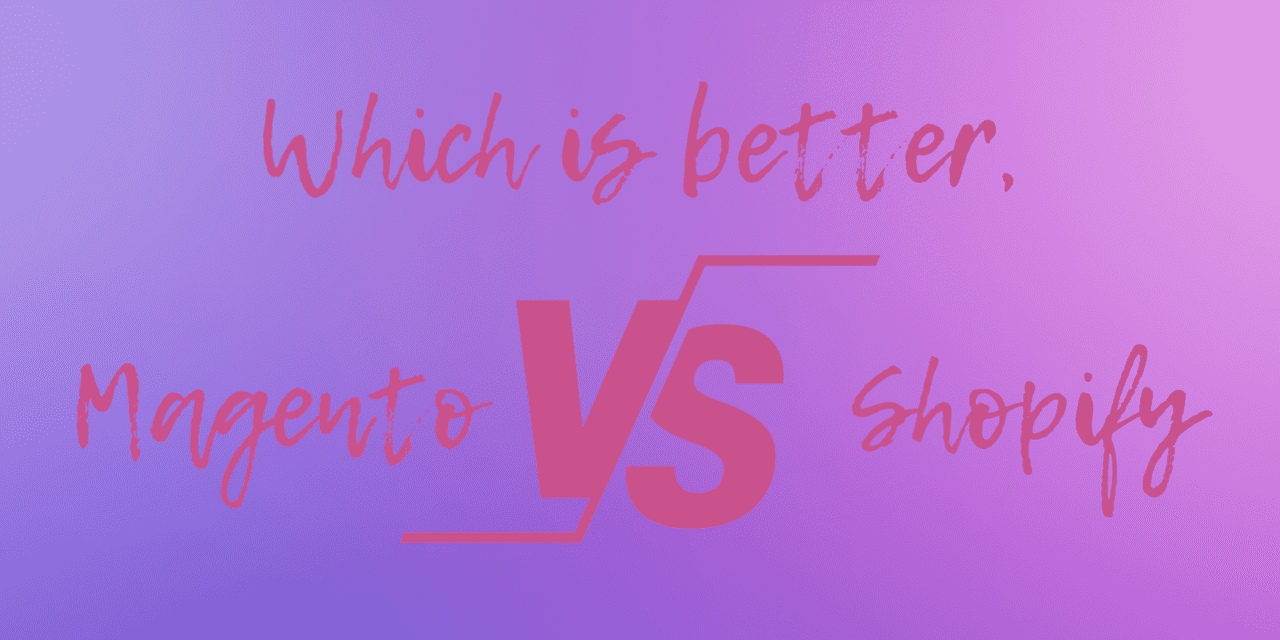As ecommerce is becoming popular and the market is getting bigger, more online store platforms are surfacing on the internet. Each one with its uniqueness, flaws, and promises to make you the best seller in your niche.
Presently, the two ecommerce store builders leading the competition are Magento and Shopify. These two are making incredible achievements and have got many people debating on the internet. There are discussions about which one is better.
Do you also seek answers? Perhaps, you’re about to launch an ecommerce store and don’t know which one to pick. Don’t worry! This article is all you need to know about the differences and similarities between these platforms.
We urge you to sit tight, grab a cup of coffee or a cup of your favorite drink, and follow through till the end.
Magneto Vs. Shopify
Magneto is a product from Adobe, the computer software producing company based in San Jose, California. This product is an open-source code that programmers, website developers, and businesses can adopt to create beautiful and functioning ecommerce stores.
The open-source code can be downloaded for free. However, the company also offers two other subscription plans that businesses could subscribe in to scale their business and generate more revenue. Magento is a good ecommerce platform and has garnered over 250,000 users across the globe.
On the other hand, is Shopify, an ecommerce created in 2006 by two men who were trying to develop a website for their snowboarding business. They were dissatisfied with what they made and kept improving and upgrading the platform until they created the Shopify we have today.
Shopify is the third-biggest retail company in the United States, after Amazon and eBay. This ecommerce machine is currently engineering over 2 million online stores globally. And it alone possessed 20% of the ecommerce market and processed over $5.1 billion transactions in 2020. It has equally helped merchants to create awesome websites.
Shopify is taking the lead on stats and numbers. Nothing less can be expected from a platform that has been in the business for more than a decade. Time could be the reason for their success.
Let’s get intense about this comparison by reviewing both platforms based on some key features.
Magento Vs. Shopify: A fight of features comparisons
- Ease of Use
Shopify gets a win on this one. Shopify is simple to use. You will probably get everything done by dragging your mouse and clicking buttons. The case is different for Magento. If you aren’t familiar with website development, you might find it difficult to open a site using the platform.
Opening a website using Magento can be a bit technical. It requires that one must understand the workings of server and hosting. Moreover, if you host the website on a server that doesn’t supports one-click Magento installation, you may have to learn the method of file transfer using FTP.
The experience with Shopify is different. Choosing Shopify for ecommerce will automatically put your website on their server. You will need to buy a domain name at an additional cost on Shopify. And there’s no problem with getting it from a different domain address registrar.
Shopify is more simplified than Magento because you don’t have to visit another platform to get your themes and extensions. Unlike Magento, which requires users to have an account on their marketplace, where they can purchase themes and extensions. For Shopify, you can access everything you want on the platform without opening another tab on your browser.
- Themes and Design
Shopify and Magento are both performing well in this aspect. The two platforms offer both free and paid themes. Magento has more free themes in its library than its competitor. Shopify has a limited number of free themes, but these designs are more contemporary than those on Magento.
Shopify has over 1400 free themes and templates from which users can select anyone that best suits their business niche. The opposition platform currently has only 56 themes. However, they come at a more affordable price compared to Shopify’s.
Nevertheless, the number of themes offered by an ecommerce platform does not make it great unless it gives users the full customization ability to tailor the website to their taste. Magento does not offer much customization control to users, except the user is a programmer who can work on the theme’s codes.
The joy of using an Open-source ecommerce platform like Magento is that you can change the way everything looks if you have the programming skills required for editing CSS and HTML documents. You can hire a Magento developer to tweak things around if you don’t know how to go about it.
But without that, you can only change your content and page format using the Magento page builder. By dragging and dropping page and content elements, you can build product sliders, add banners, and upload videos.
On the other hand, Shopify users can make changes just by hovering their mouse and making some clicks using the Shopify theme editor tool. Without the knowledge of programming, store owners can change the color and font of their site.
But if you desire to make more changes, you need to hire a programmer that can code liquid, a language developed by Shopify and used to code all their themes.
- Blogging and SEO capabilities
There is no blogging limit for both platforms. Nowadays, stores are creating amazing blogs on their Shopify store. If you’re still not convinced, you can check the blog section of Gaiam, a store that specializes in the selling of Yoga equipment.
Blogging on the Magento store can’t be doubted. As a free, open-source code, you can have your programmer design a unique and dynamic blog section for your online store. Meanwhile, you can also get the blog extension on the Magento marketplace to avoid the coding solution.
The two websites are doing great as far as SEO is concerned. They would have nearly the same score if we were to rank them—credits to their support for blogging, image optimization, and speed optimization.
You can compete for top spots on SERPs with any of the two platforms. All you need to do is to adhere to the SEO rules and follow Google algorithm updates.
Inventory Management
Inventory management is the soul of the ecommerce platform. There’s no point calling a platform an excellent online store provider if it can’t manage product inventory efficiently. Both Magento and Shopify have a pass on this one, to your surprise.
They both support an unlimited number of products. But just so you know, Magento sites could experience slowness when the product database is becoming extremely too much. And this is because these hosting servers have a maximum limit.
No matter the number of products you have on Shopify, your online store will remain functional and unshaken. As a self-hosting ecommerce platform, they provide their users with enough space to handle an unlimited number of products without causing speed lagging.
One of the reasons both platforms are rated high in the ecommerce industry is that users can easily edit their product inventory. You can add and delete products collectively.
- Apps and extensions
It’s been a tough competition. But finally, we have something Magento has better than Shopify— extensions. These extensions will enable you to improve the functionality of your online store. You can’t conclude that Magento can’t perform a task until you have gone through its list of thousands of extensions.
You can find an extension for any additional functionality you want to add to your store. Maybe you want a banner slider or a gift card function. There’s always an extension to get your desire up and running on your ecommerce store.
Shopify is also doing excellently well with its third-party app integration. This platform has many free and paid third-party apps to improve site functionality and attract more sales.
The minor problem with Shopify apps is that some require coding for integration. However, you can still install some with a few clicks on your mouse.
- Sales channel
The best multichannel ecommerce platform will always go to Shopify. By integrating sales channels available in the third-party app library, you can sell your Shopify products on popular social networks like Facebook, Instagram, and TikTok. You can also connect your Shopify site to other ecommerce platforms on Amazon and Walmart.
For now, the only sales channel supported on Magento is Amazon. Perhaps, in the future, we will have more. These sales channels will assist you in expanding your reach and making more sales.
- Payment Processor
Yet another one that Magento and Shopify will have almost the same score. Shopify has its payment processor, through which you can avoid charges and deductions. Aside from theirs, users have 100 more third-party processors at their disposal. You can have the common ones set up to accept payments from buyers.
Magento is leading with more than 150 payment processors. You can get as many as possible in the extension part of their marketplace. The difference here is that Magento offers payment solutions capable of international transactions, while Shopify wins with its own quick and easy payment processor.
- Shipping and Shipping charges
The two ecommerce platforms have enough shipping options for merchants. Meanwhile, their shipping charges are flexible and could be made transparent using tools available on the platforms.
Shopify, for instance, offers some drop shipping tools that provide accurate shipping charges estimates. Moreover, some devices use a shipping calculator for displaying shipping costs to customers.
- Cost
Magento subscription has three tiers. The most common is open source, which you get for free. Anyone can proceed to their website to download the codes and start utilizing them to build their online store. However, free source code does not imply all free.
You still need to budget like $10 for a domain name. And purchase hosting is usually priced between $5 to $100 monthly. Also, intended users will have to set aside $500 for themes, extensions, maintenance, and unforeseen expenses. The cost could be more if a programmer or website designer is hired.
Magento also offers two package tiers that come at high prices. The first one is Magento commerce, formally known as Magento enterprise, and the second is the Magento Commerce Cloud. Magento commerce could cost between, $22,000 to $125,000 per annum.
And it’s designed with some exceptional services that promise more sales, customer satisfaction, and technical support from the Magento team. Magento commerce cloud is a commerce package plus hosting on the Amazon AWS server and files stored in a safe and secured cloud. The price for this plan ranges between $40,000 to $180,000 per year.
Like Magento, Shopify offers three plans: basic, Shopify business, and Advanced. Each cost $29, $79, and $299 respectively. The higher the cost, the more the available tools and satisfaction. These prices are for hosting on the Shopify server. It doesn’t include the separate cost for themes, domain names, and add-ons. Also, there are charges on every transaction.
There’s no setup cost for Shopify. Anyone with or without any computer proficiency can open a store on Shopify. Besides, there’s a 14-day trial for you to test the platform before choosing a plan.
Which one is the best, Shopify or Magento?
This is hard. Each platform has its strengths and weaknesses, and both tie in some aspects.
Shopify is straightforward to use and can be managed by a business without an IT professional. Moreover, a massive community of users and a 24/7 support system ready to assist whenever you’re experiencing any technical problem.
Magento is free, but not free, and yet it might require a professional for setup. Therefore, it’s considered second to Shopify in this review of the best ecommerce platform. Shopify wins the competition. However, Magento is an excellent online store provider if you can overlook the little task involved in setting up a website. It would probably save you more expenses compared to Shopify.
Do you want to try Shopify’s free 14-days trial? Click here to get started. But before then, read our article on the Shopify store setup guide.
And you can start your journey with Magento by first checking our content on how to set up your online store with Magento.








